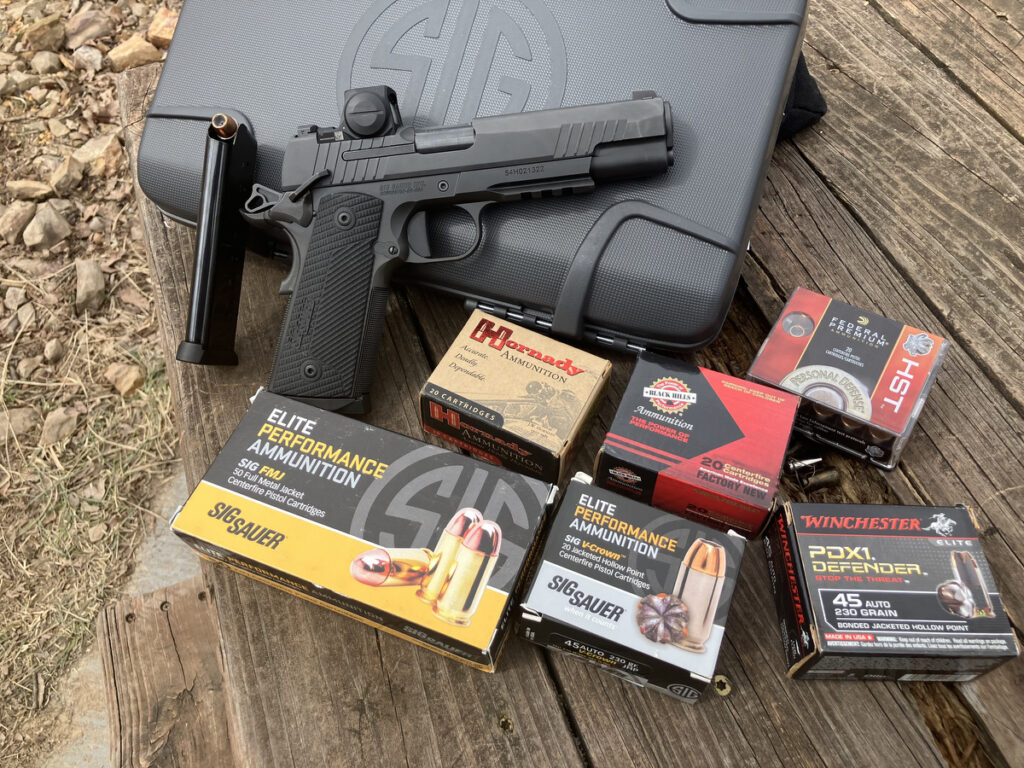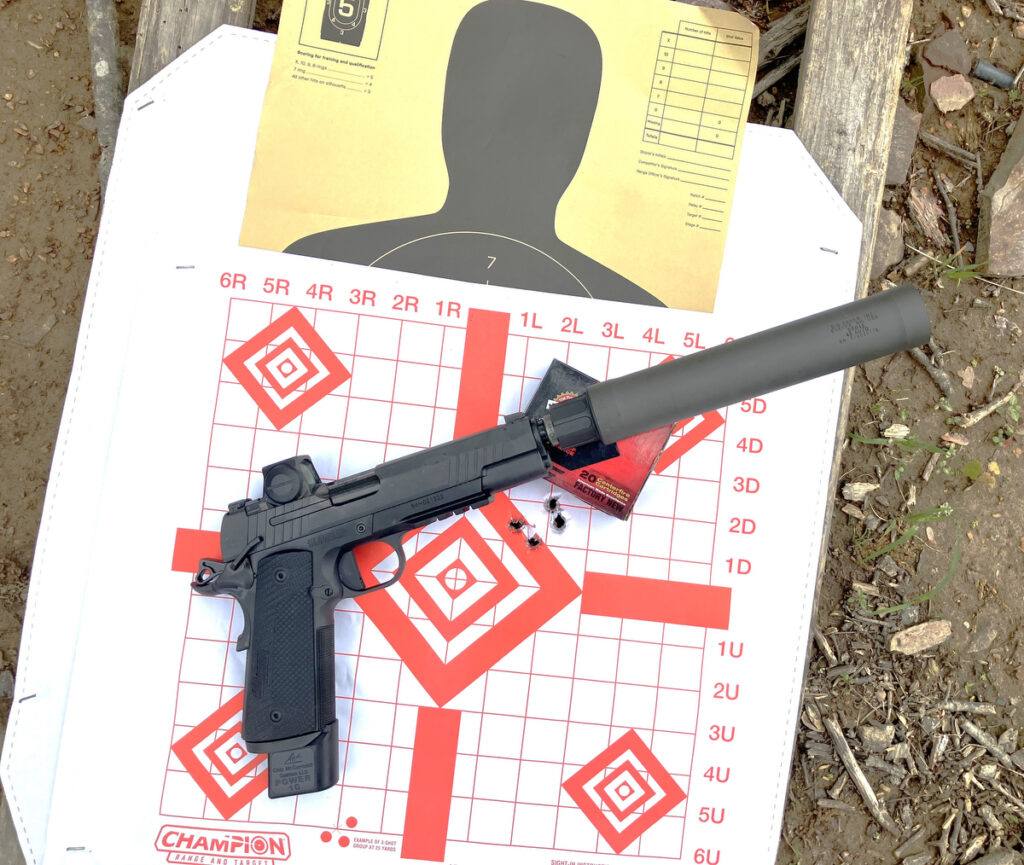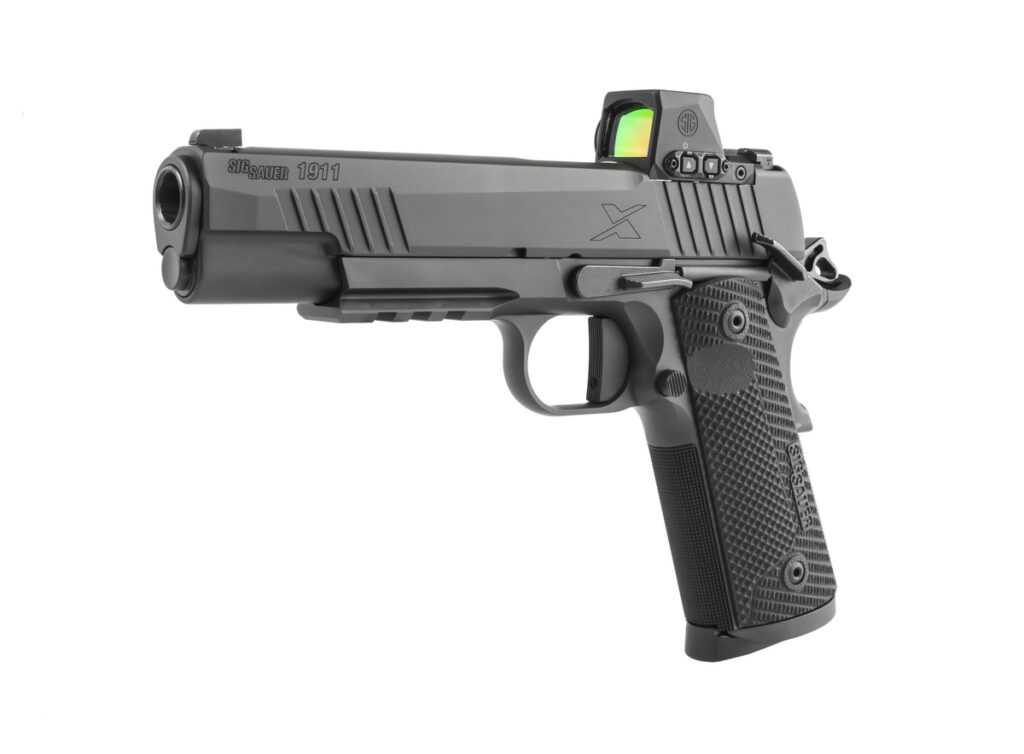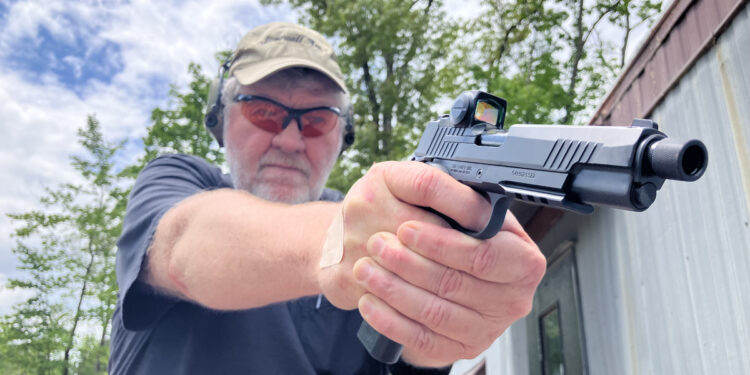With the 1911-XFULL, SIG Sauer is offering a new take on the classic 1911. I do not intend to rehash all the well-known 1911 design characteristics. Thousands of articles and books have already covered the iconic 1911. The full-size, black, stainless steel SIG 1911-XFULL attracts attention with its all business air including XRAY3 day/night sights, flat bladed trigger, checkered front and rear straps, and custom G10 grip panels from LOK Grips. Railed dustcover frame with undercut trigger guard, flat mainspring housing, extended ambidextrous manual safeties and slide stops, front and rear XSERIES slide serrations, external extractor, and removable metal magwell finish up the pistol’s form-follows-function feature set. The most noteworthy addition SIG has made to “1911 world” via the 1911-XFULL is the SIG ROMEO-X Compact red dot sight that’s mounted from the factory.
That’s right—SIG has introduced the single stack 45ACP 1911 platform to the red dot age. One has to wonder why it’s taken so long. Could it be that manufacturers mistakenly labeled single stack 45ACP 1911 owners as not appreciative of red dot benefits? Anyone clinging to their single stack 1911 isn’t progressive enough to adapt to the times? That’s doubtful, I’m just trying to stir you up. Let’s just say SIG was taking its time, exploring the best way to make the 1911 red-dot-compatible, and the long-awaited result is the 1911-XFULL.

SIG invested the time and brain power to figure out the best way to mount a red dot to the slim 1911 slide, then committed the necessary resources in terms of machines and personnel to make it happen. The 1911-XFULL arrives with an ultra-low-profile, direct-mount optic slide cut in front of the rear sight. The SIG ROMEO-X Compact red dot is ideal for use with the XFULL thanks to its low deck height which allows standard-height iron sights to co-witness. A Shield RMS-c footprint is used.
The 1911 platform is still very popular with consumers. This is confirmed by the number of 1911 models on the market… with new 1911 models still being introduced. Major firearm manufacturers know having a 1911 in their catalog is a must. 1911 performance justifies it still being a valid choice for use albeit personal defense or duty. The SIG 1911-XFULL demonstrates the 1911’s versatility and potential.
MR. BROWNING STILL RULES
For many, there’s no debate over choosing a personal defense handgun. Any discussion starts and stops with John Browning’s 45 ACP 1911. The association between the 45 ACP cartridge and the 1911 platform is seamless. Browning was not only the architect of what many feel is the ideal handgun form—the 1911—but also the originator of the perfect personal defense handgun cartridge—the 45 ACP. SIG only builds upon these bulwark 1911 characteristics with its new pistol.

In this day and age of polymer, high-capacity handguns, the 1911 has turned into an aficionado’s weapon that attracts users with its natural handling, great trigger, and potent 45 ACP chambering. Yes, higher capacity, polymer-framed, striker-fired weapons have supplanted it in terms of general use. This is due to a variety of reasons outside the purview of this article. However, when you put a full-size 1911 in your hand, you quickly realize there’s nothing like it in the polymer world we live in. The allure of a well-put-together 1911 single-action semi-automatic handgun is hard to deny. No substitute for the confident heft of a steel frame with “cocked and locked” trigger begging to be set free.
Is the 45 ACP 1911 a prime weapon of choice for all situations or users? Of course not. However, no one can argue that there is a more instinctive handling weapon than the 1911. The trigger and grip size and angle cause it to be most accurate handgun in most arsenals. Why do you think hostage rescue units and other special purpose military and law enforcement teams still hold onto using it? It is accurate and conducive to precise shot placement. Along these same lines, no one can argue that the 45 ACP does not deliver the terminal ballistic payload. Many scoff at its limited single-stack capacity—8-rounds with the SIG 1911-XFULL. Practically speaking, eight rounds of 45 ACP will solve most problems. 10-round magazines mitigate some of this criticism. Chip McCormick Custom 10-round magazines supplemented the eight rounders that arrived with the 1911-XFULL for this article. This is not an attempt to start a 9mm versus 45 ACP debate. Modern 9mm loads have ended the banter of 9mm not being worthy of consideration. With that said, there is no denying the sensation of touching off a 230-grain full-power 45 ACP load even in a steel handgun weighing 42 ounces.
SPICING THINGS UP
In the spirit of the SIG 1911-XFULL giving off connoisseur vibes, I decided to separate it even further from the polymer frame striker fired horde by switching out the standard barrel for a threaded one. Fortunately, SIG offers a threaded barrel as an accessory. The SIG 45ACP threaded barrel proved drop-in compatible with the 1911-XFULL. This was a pleasant surprise, as many times a replacement anything with a 1911, let alone a barrel, will require fitting. The threaded barrel was added to enable the use of a SIG SRD45 suppressor. This suppressor was acquired several years back and has been replaced by the SIG MODX-45 model in SIG’s current lineup. The Chip McCormick 10-rounders protruding from the magwell seemed to balance out the suppressor, feel-wise and aesthetically.

The ROMEO-X Compact red dot proved the optimum way to operate the 1911-XFULL with a mounted suppressor, both eyes open with the red dot hovering above the SRD45 can. The ROMEO-X Compact offers a variety of built in red dot reticle patterns. I decided to use the circle/dot for this evaluation. The ROMEO-X red dot assisted in engaging targets at close distances with the red dot easy to pick up rapidly. Point shooting with the 1911-XFULL is still very feasible when using the ROMEO-X’s window as a ghost ring if forced to react spontaneously to a threat.
The SIG ROMEO-X Compact is a red dot offering 20,000 hours of runtime at its medium brightness setting and uses MOTAC (Motion Activated Illumination). The housing is made from 7075 aircraft-grade aluminum featuring machined, anti-reflection grooves on shooter-facing surfaces with distortion-free aspheric glass and a patent-pending beryllium copper flexure-arm adjustment system. The ROMEO-X incorporates a point source red LED emitter with a 2 MOA dot and a 32 MOA circle reticle with side-mounted independent brightness adjustment buttons, 15 brightness setting (including night vision settings) and a side-mounted CR1632 battery compartment with a threaded battery cap so the optic does not need to be removed from the pistol for battery changes.
FEEL THE POWER
While the bulk of firing was with 230-grain FMJ ammunition, an assortment of premium ammunition was proofed through the SIG 1911-XFULL, such as Hornady Custom XTP, Winchester PDX-1, Black Hills Ammunition 230-grain FMJ and JHP, Federal HST, and SIG Sauer V-Crown with 185-grain, 200-grain and 230-grain JHPs to verify reliability regardless of bullet profile or weight.

Initial evaluation with the 1911-XFULL as it arrived from SIG (sans threaded barrel) was all positive and exhibited excellent accuracy. The first order of business after adding the threaded barrel and suppressor was to verify that they caused no reliability issues with the pistol. As mentioned earlier, the threaded barrel had no issues after being dropped in. The suppressor also caused no problems with reliability. I was surprised by how much of a re-zero adjustment was necessary with the threaded barrel compared to the original barrel. 4-inches low and left at only 15 yards! Thankfully, accuracy was maintained—just not same place on target, thus requiring adjustment of the optic. The mounted suppressor also caused a slight shift of the point of aim versus the point of impact compared to the bare threaded barrel. While not as severe as changing barrels, the shift in POI was noted.
PERFORMANCE
| Avg. Velocity | Avg. 5-Shot Group 25 yards (in.) | Best 5-Shot Group 25 yards (in.) | |
| Federal 230-gr HST | 881 fps | 2.33 | 2.25 |
| SIG 230-gr V-Crown | 863 fps | 2.75 | 2.5 |
| Black Hills 230-gr FMJ | 843 fps | 2.5 | 2.33 |
| Hornady 230-gr XTP+P | 922 fps | 2.75 | 2.66 |
230-grain 45 ACP loads are subsonic and an obvious choice for use with a suppressor. The 230-grain loads’ ability to reliably function in the 1911-XFULL, while still being subsonic, is one of the reasons why 45 ACP handguns are a favorite suppressor host. The SIG SRD45 proved effective at taming the muzzle blast of even 185-grain and 200-grain supersonic loads. All loads could be comfortably fired without the use of ear protection with the SRD45 installed, even in an indoor environment.

Various scenarios engaging targets from behind cover or on the move were run. The natural pointability of the 1911-XFULL comes into its own in this realm with the ROMEO-X Compact doing its part, as well. The ROMEO-X’s rectangular lens offers a superior field of view compared to other red dot options. The ROMEO-X’s minimal frame “disappears” when focusing on the target with the red dot. The reticle is crisp with no halos or disfiguration. The red dot was “there” and seamlessly located at first draw. This is a benefit of SIG choosing a direct mount method versus plates, allowing the ROMEO-X to sit as low as possible in the slide.
Magazine change drills were done for the dual purpose of getting a feel for manipulating the 1911-XFULL with the ROMEO-X Compact installed while making sure the red dot was seamlessly picked up after reloads and placed back on target. The combo performed way better than expected. Here was a weapon designed in the 1900’s, combined with red dot, more than holding its own in 2024.
OBSERVATIONS
A full-length guide rod is NOT employed in the SIG 1911-XFULL, but rather a plug bushing and spring as designed by Browning. This will warm the heart of many 1911 purists who deride the use of full-length guide rods as a solution to a problem that does not exist with the 1911; not to mention the full-length guide rod contributes to “over tightness” in the 1911 design that may cause finicky behavior in the reliability department. This is not the case with the 1911-XFULL. In fact, you can field strip the 1911-XFULL without having to resort to using a bushing wrench.

Here’s an interesting thing about the two 8-round magazines that arrive with the pistol. While function was no issue, I found that closing a locked rearward slide on an empty magazine was damn near impossible using the slide release lever. The same magazine when loaded posed no problem. Other magazine types used during my test and evaluation didn’t interfere when closing the slide with an empty magazine. Whether or not this is a real-world problem is up for the user to decide.
You have to wonder how many hours of engineering (and then analyzing best build practices) were required to find the proper balance between accuracy and reliability? Whatever it was, SIG pulled it off. Shooting five-shot groups from sandbags regularly produced a jagged single hole at 12 yards with the SIG 1911-XFULL ROMEO-X Compact duo. The pistol chugged thru round after round of 45 ACP during high volume drills.

The SIG 1911-XFULL serves as reminder as to why the classic design still holds a prominent place in the world. Users and manufacturers are keeping the 1911 going strong and the SIG Sauer 1911-XFULL certainly doing its part in that regard. The SIG duo I tested here is a solid combination, functionally speaking. It takes a backseat to nothing in terms of lethality, while still allowing a user to indulge by not having something so typical.
SPECIFICATIONS
| Make | SIG Sauer |
| Model | 1911-XFULL |
| Caliber | 45 ACP |
| Weight (empty) | 42 oz. |
| Overall Length | 8.7 in. |
| Barrel | 5 in. |
| Magazine Capacity | 8-rounds |
| MSRP | $1799 with ROMEOX installed |
| Info | sigsauer.com |












